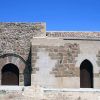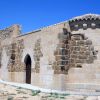Given the architectural development in the region and the monumental ambition of the collegiate church of Santa Maria in Berbegal, this small Romanesque chapel seems somewhat modest in comparison. It is set apart from the village in a sparsely populated area that is given over to agriculture, and its location can only be explained by its proximity to the historical Roman route that later made up part of the St James Way.
It has a single nave and a curved apse preceded by a simple, rectangular area. Although modest and relatively small, it has the power to move and surprise those who visit as is the case with many similar Romanesque buildings. The humility and simplicity of the chapel makes it great.The master builders of the Romanesque era used stone to distinguish the house of God from the house of man with the aim of creating an eternal place with symbolic character.
In order to support the heavy stone vaults the walls are incredibly thick and lack apertures. This affords the exterior of the church a solid and secure appearance and gives an impression of strength and peace. The interior offers semi-darkness that is symbolic, holy and protective.
The square is the principal element that governs architectural design. It is the earthly symbol par excellence and has been used since the origins of ancient cultures from the Middle East. It also makes numerological reference to the elements - air, earth, water and fire – the cardinal points, the seasons of the year and the four evangelists.
The semicircular apse and its dome represent the circle and symbolise the celestial vault, incorporeal like divinity, and providing a contrast to the intrinsically changeable material of the four elements of the earth. The inclusion of both the circle and the square indicate the location of the holiest part of the temple.The original Romanesque structure has undergone many renovations, the most noticeable of which took place in the 18th century. The nave was widened towards the west end with a new section that opened into an arched doorway. The keystone at the point of the arch shows the municipal symbol of a cockerel and gives the date of the work as 1721.








